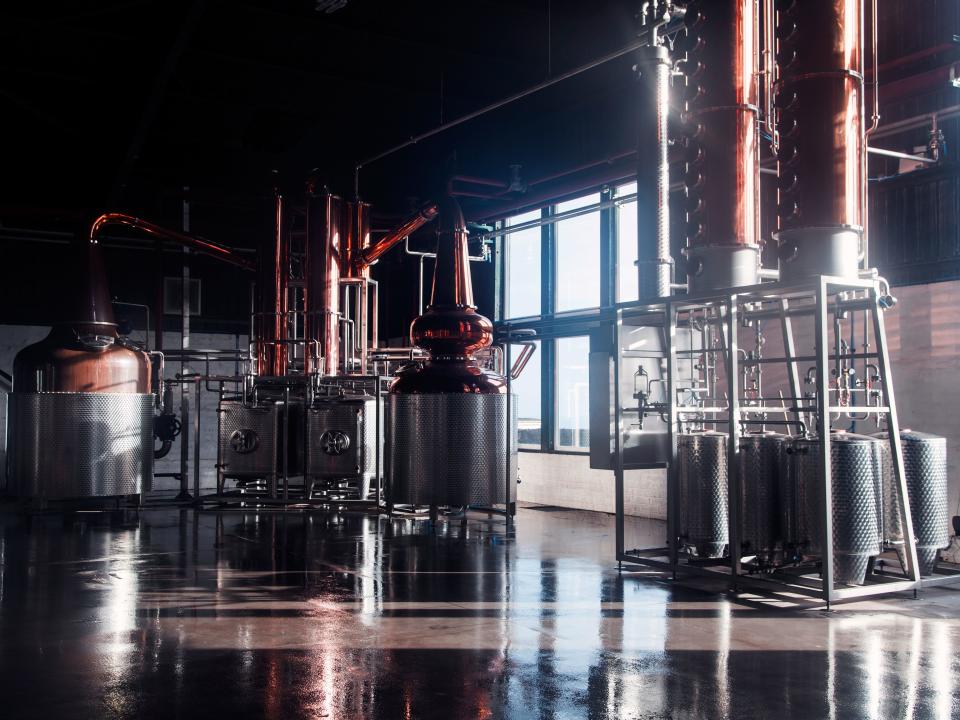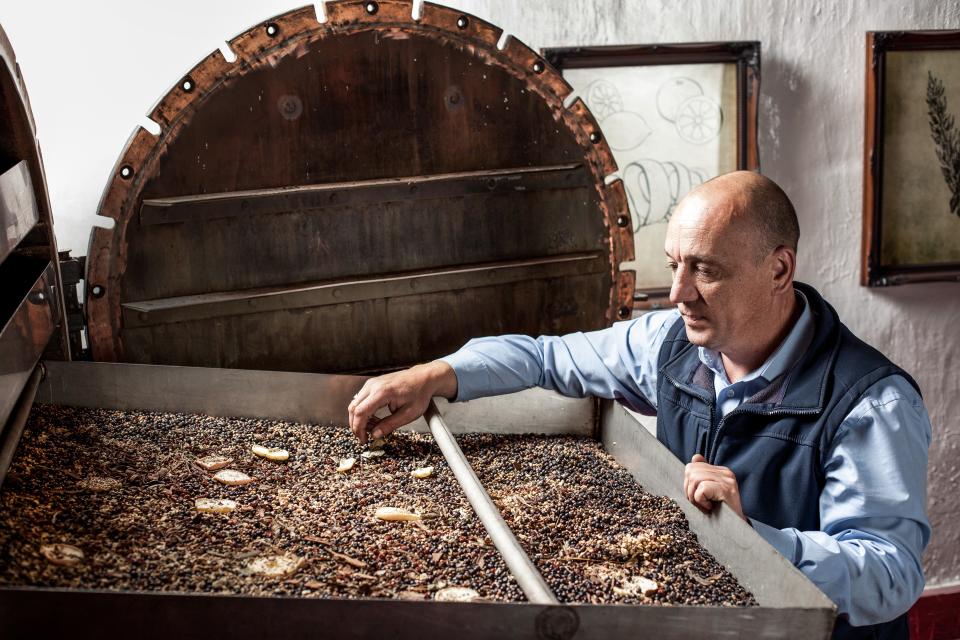Why Scotland's Gin Is as Good as Its Whisky
By Mark Ellwood. Photos: Courtesy The Botanist, Courtesy Caorunn, Courtesy Arbikie Highland Estate.
Kirsty Black stands in a chilly outbuilding in rural Scotland, surrounded by potatoes. Jolly but earnest, with huge glasses, she might resemble Hermione Granger, but her magic is real. As she picks up a large and misshapen potato, Black says that 40 percent or more are rejected by quality control standards of supermarkets, good for little more than animal feed. But where others see unloved spuds, Black sees budding profits: turning these King Edwards, Maris Pipers, and Cultras into a delicious, small batch gin.
“It’s much harder to turn potatoes into alcohol than barley—it takes four times as much raw material to distill a single batch," she says. "But it’s worth it."
Black, a former plant scientist turned master distiller, runs the craft still at Arbikie in Arbroath, on Scotland’s southeast coast. The still sits in the middle of a vast, 2,000-acre farm owned by the Stirling family, who's worked the land for generations. They run a mixed operation of dairy, barley, and especially potato production, becoming one of the United Kingdom’s largest supermarket suppliers.
Three years ago, Black was hired by the family to devise a more creative, and profitable, use for those misshaped tubers. Since then, she’s designed the farm’s still and crafted recipes for both a potato vodka and a custom gin. It’s the latter that clearly inspires her.
“In the days of the British Empire, they brought back all sorts of exotic stuff and planted it here,” Black says. “The land is so fertile around here that almost anything grows.”
She's supplemented standard juniper with a trio of flavors that rely on raw materials all drawn from the farm’s own land: blueberries (called blaeberries in Scotland), kelp, and purple thistle, Scotland’s national flower. The result is a smooth, fruity gin that Black recommends serving in an ice cold, very dry martini; she smiles slightly when she admits the owners insisted on calling it Kirsty’s gin.
“This is a farm-to-bottle operation,” Black says. “We have a well right under the distillery to supply the water, and we use locally grown stuff from the farm for the liquor.”
Though gin has long been the favored tipple of the English for centuries—both Plymouth and London Dry standard expressions are named after English cities—Scotland was long a whisky stronghold. In the past decade, though, a thriving gin culture has emerged north of the border, too—so much so, that this month, the New Orleans–based Tales of the Cocktail will stage its overseas pop-up festival in Edinburgh where there’s an ample, readymade audience. Two-thirds of the U.K.’s total gin production now takes place outside London; of that, more than two dozen craft gin distillers now operate in Scotland. This so-called "ginaissance" has even sparked a Scotland Gin Trail linking 17 producers and cocktail bars across the country, from Glasgow to the Shetland Isles.
One of the distilleries on that trail, Isle of Harris gin, is run by former Glenmorangie exec Simon Erlanger. Erlanger hired an ethnobotanist to help develop the recipe for his gorgeously packaged new gin, aiming for the taste to reflect botanicals surrounding the distillery in the Outer Hebrides (consider, too, the logistics of shipping outside ingredients to the remote site). That freelance scientist was also freewater swimmer who took inspiration from the sea surrounding the island.
“Sugar kelp is seaweed that only grows below the surface of the water. You can’t even find it at low tide,” says Erlanger. “It has a special, sweet ingredient to it, which separates it from the more bitter kelps.”
This quirky local ingredient anchors Harris gin’s recipe, and the distillery even sells special sea kelp extract by the bottle at the distillery’s onsite store. “It’s to add a bit more taste of the sea to your martini. A few drops of this water add a flavor that’s a bit like oysters. “
So how and why did Scotland’s taste turn toward gin? The first salvo was undoubtedly the launch of Hendrick’s in 1999. Though it’s easy to assume the cucumber-heavy recipe is English, largely thanks to its witty, eccentric marketing, it’s actually from Scotland, developed by William Grant, a family-owned firm headquartered in Lanarkshire. Among other brands, Grant also owns Balvenie, Tullamore Dew, and Drambuie.
“When we came out at the end of the 1990s, we looked at the way gin was made...we wanted to emphasize the craft, and skill level behind it, the way that whisky does,” says Ally Martin, brand ambassador for Hendrick's. Whisky factored in the Scottish gin boom in other ways, too: Compare its long maturing cycle (and so, delayed profits) with gin, which emerges from the still ready to sell.
“It enables us to establish a reputation while we wait for the whisky to mature, and commercially it brings in some revenue,” says Erlanger.
Talent to help steer those new stills was also in ready supply, thanks to the masters in distilling and brewing offered by Edinburgh’s Heriot-Watt University, an MIT-like science center; it claims to be the only such course in the world, and students there helped workshop Erlanger’s recipe. Arbikie’s Kirsty Black and her closest colleague, Christian Perez-Solar, both graduated from the program, too.
Gin might be the prime focus of alumni now, but the Scottish distilling industry isn’t settling at mother’s ruin and water of life. Next up: rum, with brands like Seawolf and Dark Matter competing to sate Scotland’s sweet tooth with a boozy kick.
Our Favorite Scottish Gins
Better still: You can find them in the U.S.
[Arbikie] (http://www.arbikie.com) Kirsty Black’s namesake gin, as well as her second recipe, AK, launches stateside next month.
[The Botanist] (http://www.thebotanist.com) Made by the folks behind Bruichladdich whisky, this is the only gin made on Islay, well known for the peatiness of its malts; the recipe's 22 botanicals were all foraged on the island. The result is crisp and green, thanks to ingredients like birch and spearmint leaves.
[Cadenhead Old Raj] (http://www.wmcadenhead.com/) Named as tribute to colonial-era India, this distillery, located on the west coast of Scotland’s mainland, offers two gins of varying strengths, though both include the same unusual ingredient: saffron. The expensive spice gives a yellowish tinge to the final product spirit.
[Caorunn] (http://www.caorunngin.com) Another offshoot of a whiskymaker, in this case the Balmenach distillery on Speyside, one of the oldest in the Highlands, this first debuted in 2009. Expect a citrusy, fruity kick (one of the ingredients is a rare Scottish apple). Just remember: It’s pronounced ka-ROON.
[Edinburgh Gin] (http://www.edinburghgindistillery.co.uk) The stills that produce this gin, nicknamed Flora and Caledonia, are stashed behind a brick wall inside a basement bar in central Edinburgh, and available for regular tastings and tours. This firm recently launched a range of gins stateside, including its classic, which is flavor-forward and best served mixed with a small batch tonic like the Scottish-made [Walter Gregors] (http://www.scotsman.com/lifestyle/first-ever-scots-tonic-water-made-in-aberdeenshire-1-3753530).
This story originally appeared on Conde Nast Traveler.
More from Conde Nast Traveler:
Readers' Choice Awards Reveal Best Hotels
10 Ways to Make Your Flight Hate You
The 50 Most Beautiful Places in Europe
The Most Beautiful Coastal Towns in Italy



